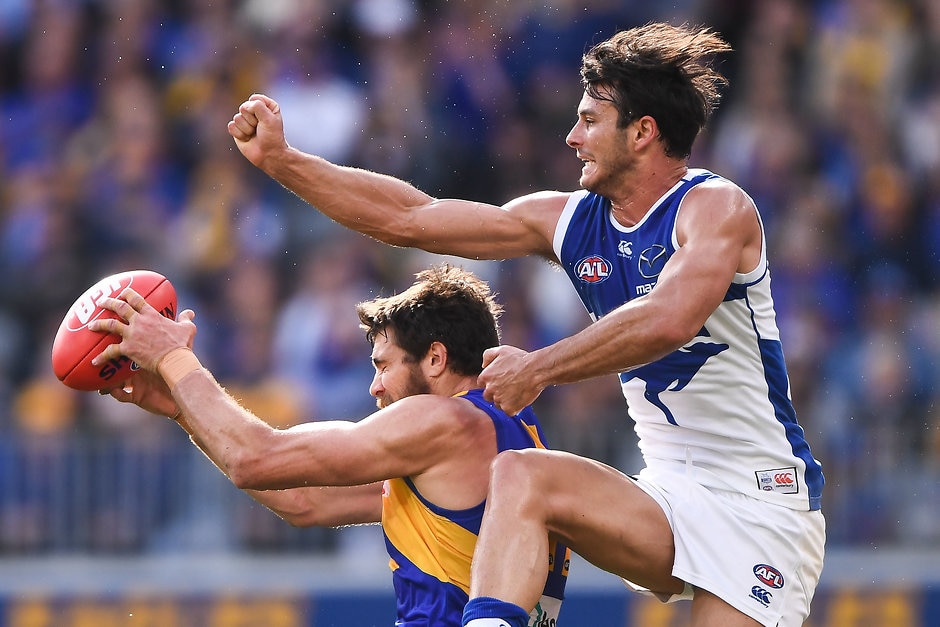THE UNLUCKY ones.
The discussion once the Virgin Australia AFL All Australian squad is announced quickly turns to the names missing from the elite and deserving list of 40.
Lance Franklin (2018) and Michael Hibberd (2017) made the final 22 in the past two seasons despite playing only 18 games, whereas no one who appeared fewer than 19 times is in this year's squad.
WHO MADE IT? The 2019 All Australian squad revealed
That appears to have cruelled the chances of Giants stars Stephen Coniglio (15 matches) and Lachie Whitfield (16), who otherwise would have been strong contenders.
AFL.com.au has taken a look at the numbers to figure out why the selectors may have made some of their tougher calls.
Who made it: Ben Brown (North Melbourne)
Who could have: Tom Lynch (Richmond)
Both played 22 games, so a comparison is pretty straightforward. Brown had more goals (64-54), disposals (244-226), contested possessions (145-137), marks (108-103), score involvements (141-138) and tackles in forward 50 (21-19). Lynch had the edge in goal assists (13-4), contested marks (47-35), marks inside 50 (66-62), forward-50 groundball-gets (38-32) and tackles (35-25). It's a close call but it's hard to argue with the selectors on this one.
Who made it: Daniel Talia (Adelaide)
Who could have: Robbie Tarrant (North Melbourne)
No one defended more one-on-one contests than Talia, whose 103 dwarfed Tarrant's 63. Tarrant narrowly won more of them than Talia (36.5 per cent to 34), but the Crow lost only 22.3 per cent of his compared to the Kangaroo's 30.2. Talia also had more spoils (154-139) and tackles (48-37) and had fewer goals kicked on him, but took fewer intercept marks (40-47). His defensive prowess must have won the selectors over, because Tarrant was clearly the more offensive player of the two. Tarrant comfortably had more disposals, metres gained, rebound 50s, inside 50s and score involvements.

Who made it: Shannon Hurn (West Coast)
Who could have: Jake Lloyd (Sydney) or Daniel Rich (Brisbane)
This is tougher to explain, but again, it's Hurn's defensive statistics that seem to have tipped him over the edge, although it's not an open-and-shut case. He also played only 19 games to the other two's 22. Hurn was the best one-on-one defender of all of them – just ahead of Rich and well in front of Lloyd – won more intercept possessions and intercept marks, and had more spoils than both of them. However, Lloyd had the most defensive-half pressure acts, from Rich, with daylight to Hurn. Lloyd, who made the 2018 team, led both in disposals, rebound 50s, metres gained and score involvements, while Rich had easily the most inside 50s.
Daniel Rich comes up CLUTCH in game 200! #AFLLionsNorth pic.twitter.com/yBQXMhOpRo
— AFL (@AFL) July 20, 2019
Who made it: Andrew Gaff (West Coast)
Who could have: Zach Merrett (Essendon)
Merrett is one of the stiffest players to miss out and, to be fair, isn't exactly a like-for-like for Gaff, who doesn't spend quite as much time as an inside midfielder. However, the 2017 All Australian (who was named on the wing that year) played 22 games to Gaff's 20, kicked eight goals to the Eagle's one, and beat him in contested possessions, clearances, inside 50s and score involvements, and had more than double as many centre clearances and tackles. Gaff, on the other hand, averaged more disposals, uncontested possessions, marks and metres gained – and is arguably the game's best two-way runner. Gaff's numbers give him the edge over more traditional wingers Brad Hill and Ricky Henderson.
The pick-up. The run. The punt from 60m.
— AFL (@AFL) July 19, 2019
Zach Merrett! #AFLCrowsDons pic.twitter.com/TfQcwyQBaI



